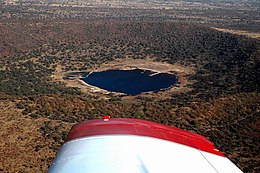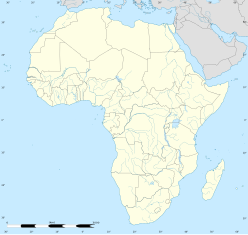
A meteorite is a solid piece of debris from an object, such as a comet, asteroid, or meteoroid, that originates in outer space and survives its passage through the atmosphere to reach the surface of a planet or moon. When the original object enters the atmosphere, various factors such as friction, pressure, and chemical interactions with the atmospheric gases cause it to heat up and radiate energy. It then becomes a meteor and forms a fireball, also known as a shooting star; astronomers call the brightest examples "bolides". Once it settles on the larger body's surface, the meteor becomes a meteorite. Meteorites vary greatly in size. For geologists, a bolide is a meteorite large enough to create an impact crater.
The Tunguska event was an approximately 12-megaton explosion that occurred near the Podkamennaya Tunguska River in Yeniseysk Governorate, Russia, on the morning of June 30, 1908. The explosion over the sparsely populated Eastern Siberian Taiga flattened an estimated 80 million trees over an area of 2,150 km2 (830 sq mi) of forest, and eyewitness reports suggest that at least three people may have died in the event. The explosion is generally attributed to a meteor air burst: the atmospheric explosion of a stony asteroid about 50–60 metres in size. The asteroid approached from the east-southeast, and likely with a relatively high speed of about 27 km/s (60,000 mph). It is classified as an impact event, even though no impact crater has been found; the object is thought to have exploded at an altitude of 5 to 10 kilometres rather than having hit the surface of the Earth.

A Martian meteorite is a rock that formed on Mars, was ejected from the planet by an impact event, and traversed interplanetary space before landing on Earth as a meteorite. As of September 2020, 277 meteorites had been classified as Martian, less than half a percent of the 72,000 meteorites that have been classified. The largest complete, uncut Martian meteorite, Taoudenni 002, was recovered in Mali in early 2021. It weighs 14.5 kilograms and is on display at the Maine Mineral & Gem Museum.

A chondrule is a round grain found in a chondrite. Chondrules form as molten or partially molten droplets in space before being accreted to their parent asteroids. Because chondrites represent one of the oldest solid materials within the Solar System and are believed to be the building blocks of the planetary system, it follows that an understanding of the formation of chondrules is important to understand the initial development of the planetary system.

Tektites are gravel-sized bodies composed of black, green, brown or grey natural glass formed from terrestrial debris ejected during meteorite impacts. The term was coined by Austrian geologist Franz Eduard Suess (1867–1941), son of Eduard Suess. They generally range in size from millimetres to centimetres. Millimetre-scale tektites are known as microtektites.

A chondrite is a stony (non-metallic) meteorite that has not been modified, by either melting or differentiation of the parent body. They are formed when various types of dust and small grains in the early Solar System accreted to form primitive asteroids. Some such bodies that are captured in the planet's gravity well become the most common type of meteorite by arriving on a trajectory toward the planet's surface. Estimates for their contribution to the total meteorite population vary between 85.7% and 86.2%.
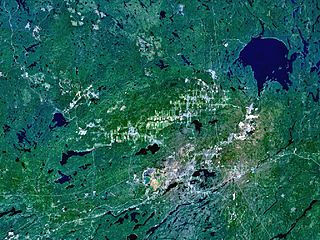
The Sudbury Basin, also known as Sudbury Structure or the Sudbury Nickel Irruptive, is a major geological structure in Ontario, Canada. It is the third-largest known impact crater or astrobleme on Earth, as well as one of the oldest. The crater was formed 1.849 billion years ago in the Paleoproterozoic era.

Kaali is a group of nine meteorite craters in the village of Kaali on the Estonian island of Saaremaa. Most recent estimates put its formation shortly after 1530–1450 BC. It was created by an impact event and is one of the few impact events that has occurred in a populated area.

Mistastin crater is a meteorite crater in Labrador, Canada which contains the roughly circular Mistastin Lake. The lake is approximately 16 km (9.9 mi) in diameter, while the estimated diameter of the original crater is 28 km (17 mi). The age of the crater is calculated to be 36.6 ± 2 million years (Eocene).

The Vredefort impact structure is the largest verified impact structure on Earth. The crater, which has since been eroded away, was around 180–300 km (100–200 mi) across when it was formed. The remaining structure, comprising the deformed underlying bedrock, is located in present-day Free State province of South Africa. It is named after the town of Vredefort, which is near its centre. The structure's central uplift is known as the Vredefort Dome. The impact structure was formed during the Paleoproterozoic Era, 2.023 billion years ago. It is the second-oldest known impact structure on Earth, after Yarrabubba.

The Canyon Diablo meteorite refers to the many fragments of the asteroid that created Meteor Crater, Arizona, United States. Meteorites have been found around the crater rim, and are named for nearby Canyon Diablo, which lies about three to four miles west of the crater.
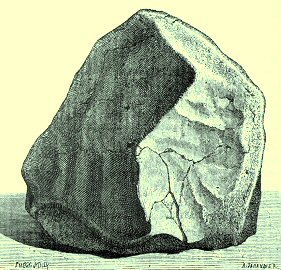
Orgueil is a scientifically important carbonaceous chondrite meteorite that fell in southwestern France in 1864.

The Meteoritical Society is a non-profit scholarly organization founded in 1933 to promote research and education in planetary science with emphasis on studies of meteorites and other extraterrestrial materials that further our understanding of the origin and history of the Solar System.

The origin of water on Earth is the subject of a body of research in the fields of planetary science, astronomy, and astrobiology. Earth is unique among the rocky planets in the Solar System in having oceans of liquid water on its surface. Liquid water, which is necessary for life as we know it, continues to exist on the surface of Earth because the planet is at a distance, known as the habitable zone, far enough from the Sun that it does not lose its water, but not so far that low temperatures cause all water on the planet to freeze.
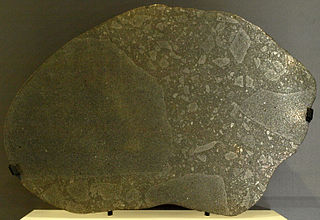
Enstatite chondrites are a rare form of meteorite, rich in the mineral enstatite. Only about 200 E-Type chondrites are currently known, comprising about 2% of the chondrites that fall on Earth. There are two main subtypes: EH and EL, classified based on their iron content.
CI chondrites, also called C1 chondrites or Ivuna-type carbonaceous chondrites, are a group of rare carbonaceous chondrite, a type of stony meteorite. They are named after the Ivuna meteorite, the type specimen. CI chondrites have been recovered in France, Canada, India, and Tanzania. Their overall chemical composition closely resembles the elemental composition of the Sun, more so than any other type of meteorite.
Asteroidal water is water or water precursor deposits such as hydroxide (OH−) that exist in asteroids. The "snow line" of the Solar System lies outside of the main asteroid belt, and the majority of water is expected in minor planets. Nevertheless, a significant amount of water is also found inside the snow line, including in near-earth objects (NEOs).
The K/U Ratio is the ratio of a slightly volatile element, potassium (K), to a highly refractory element, uranium (U). It is a useful way to measure the presence of volatile elements on planetary surfaces. The K/U ratio helps explain the evolution of the planetary system and the origin of Earth's moon.
CM chondrites are a group of chondritic meteorites which resemble their type specimen, the Mighei meteorite. The CM is the most commonly recovered group of the 'carbonaceous chondrite' class of meteorites, though all are rarer in collections than ordinary chondrites.
Monturaqui is an impact crater in Chile. It lies south of the Salar de Atacama and was formed 663,000 ± 90,000 years ago by the impact of an IAB meteorite. It is 350 m × 370 m wide and 34 m (112 ft) deep and contains a salt pan. Only a few remnants of the meteorite that formed the crater have been collected, with most of the rocks being of local origin. The crater was discovered in 1962 and identified as an impact crater in 1966.
